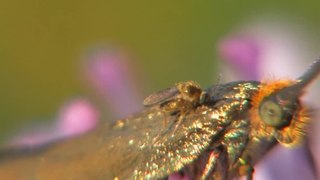
Ceratopogonidae is a family of flies commonly known as no-see-ums, or biting midges, generally 1–3 millimetres in length. The family includes more than 5,000 species, distributed worldwide, apart from the Antarctic and the Arctic.

Forcipomyia is a genus of biting midges in the subfamily Forcipomyiinae. Species of the subgenus Lasiohelea suck vertebrate blood. Some species are ectoparasites on larger insects. Other species in the genus are important pollinators of the cacao tree. There are at least 1,000 described species in Forcipomyia.

Atrichopogon is a genus of biting midges, small flies in the family Ceratopogonidae.
Leptoconops zherikhini is an extinct species of biting midges belonging to the family Ceratopogonidae. This species was described from fossilized remains preserved in Lower Cretaceous amber from Álava, Spain. These fossils represents the earliest known occurrence of extant genus Leptoconops.
Leptoconops amplificatus is an extinct species of biting midge belonging to the family Ceratopogonidae. This species was described from fossilized remains preserved in Lower Cretaceous amber from Lebanon.
Leptoconops antiquus is an extinct species of biting midges belonging to the family Ceratopogonidae. This species was described from fossilized remains preserved in Lower Cretaceous amber from Lebanon.
Leptoconops burmiticus is an extinct species of biting midges belonging to the family Ceratopogonidae. This species was described from fossilized remains preserved in Burmese amber from the Lower Cretaceous. The amber containing the fossil was mined in the Hukawng Valley, Myanmar.
Leptoconops rossi is an extinct species of biting midges belonging to the family Ceratopogonidae. This species was described from fossilized remains preserved in Burmese amber from the Lower Cretaceous. The amber containing the fossil was mined in the Hukawng Valley, Myanmar.
Leptoconops brevistylus is a species of biting midge belonging to the family Ceratopogonidae. It occurs in the Damodar River valley, Jharkhand state, India.
Phaenobezzia is a genus of biting midges in the family Ceratopogonidae. There are more than 20 described species in Phaenobezzia.
Mallochohelea is a genus of biting midges in the family Ceratopogonidae. There are at least 40 described species in Mallochohelea.
Clinohelea is a genus of biting midges in the family Ceratopogonidae. There are at least 40 described species in Clinohelea.
Nilobezzia is a genus of biting midges in the family Ceratopogonidae. There are more than 70 described species in Nilobezzia.
Allohelea is a genus of predaceous midges in the family Ceratopogonidae. There are more than 30 described species in Allohelea.

Heteromyia is a genus of biting midges in the family Ceratopogonidae. There are about 17 described species in Heteromyia.

Jenkinshelea is a genus of biting midges in the family Ceratopogonidae. There are about 18 described species in Jenkinshelea.





